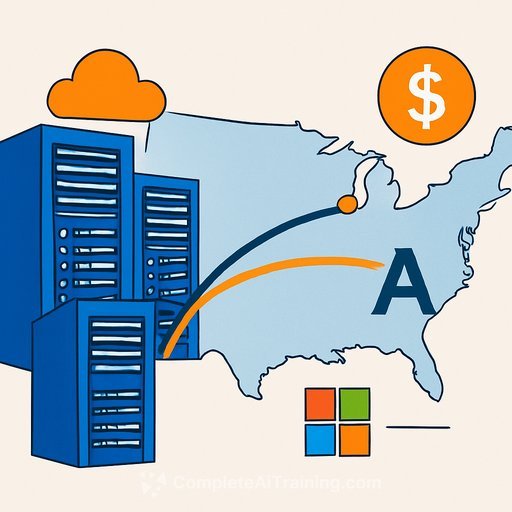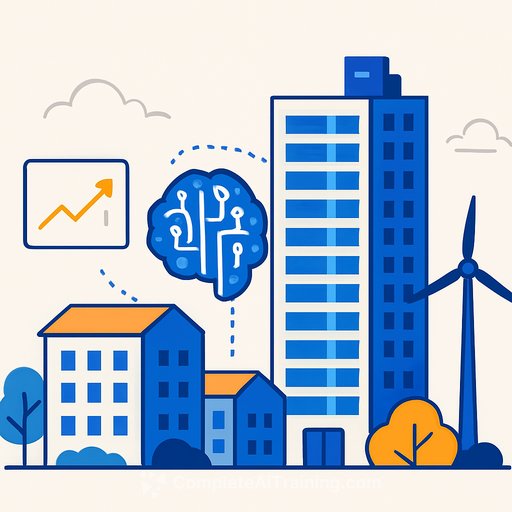Anthropic and Microsoft Announce $50B AI Data Center Build-Out: What It Means for Real Estate and Construction
Anthropic and Microsoft are accelerating their U.S. data center programs with a wave of new facilities and upgrades. Anthropic outlined a $50 billion multiyear plan with anchor sites in Texas and New York. Microsoft detailed progress on a linked Atlanta-Wisconsin build that will function as a massive supercomputing system for services like Copilot, Azure OpenAI, and advanced research.
This surge is pushing AI from software into steel, concrete, and megawatts. For developers, owners, GCs, and subs, the pipeline is real-and it's big.
Key Takeaways for Owners, Developers, and GCs
- Deal velocity is up: hyperscale timelines are compressing to 18-30 months from site control to go-live, with phased energization to pull revenue forward.
- Sites with near-term electrical service, strong fiber, and clear permits win. Interconnection queue position can be more valuable than land price.
- Expect multi-billion-dollar campuses built in stages-core-and-shell, repeatable white space, and standardized MEP blocks to scale fast.
- Single-tenant or build-to-suit structures dominate, often with long leases and expansion options tied to additional megawatt milestones.
Anthropic: $50B for Next-Gen Compute
Anthropic plans large facilities in Texas and New York designed for next-generation model training and inference. The company is tying construction to utility partnerships and renewable energy deals to support high-load operations.
Headcount will rise in construction and engineering during buildout, followed by permanent roles across data operations, cybersecurity, and site reliability. Academic and public-sector partnerships are expected to anchor research at the new locations.
Microsoft: Interconnected Supercomputing at Scale
Microsoft's Atlanta site will connect with a Wisconsin facility and run on hundreds of thousands of Nvidia GPUs. The goal: distributed training, stronger availability, and lower latency across the eastern U.S.
This fits a broader strategy-interlinking regional sites to balance workloads, de-risk outages, and support AI services for enterprise and government clients.
Market Context: Construction Is Running Hot
Industry analysts estimate AI data center projects topped $120 billion in active construction across North America in 2025. Texas, Georgia, and New York stand out for land availability, incentives, and existing grid and fiber infrastructure.
The upside is jobs, utility investment, and regional tech diversification. The pressure points: grid capacity, water availability, and zoning complexity.
What Wins Site Selection in 2025
- Electrical capacity: access to 50-300+ MW per campus, realistic interconnection dates, and proximity to substations and transmission.
- Fiber: dual diverse long-haul routes, low-latency paths to cloud regions, and carrier-neutral meet-me points.
- Permitting: clean zoning, predictable CEQA/SEPA/NEPA exposure where applicable, and a playbook for generator and battery permits.
- Cooling water plan: reclaimed water agreements or air-cooled/hybrid options where freshwater is constrained.
- Community readiness: road upgrades, tax agreements, and engagement to address noise, emissions, and construction traffic.
Construction Outlook: Risks to Manage
- Long-lead equipment: utility transformers, medium-voltage switchgear, generators, UPS, chillers, dry coolers, and busway remain schedule-critical. Pre-buy and dual-source where possible.
- GPU supply: delivery windows can ripple through commissioning dates; align white-space phasing to silicon arrivals.
- Workforce: peak labor for electrical and controls is tight. Invest in training, safety, and shift scheduling to hold dates.
- Design standardization: repeatable MEP blocks, skid-based plants, and prefab electrical rooms can cut months and reduce change orders.
Energy Strategy: Getting the Megawatts
Both firms are pairing builds with renewable energy deals, grid upgrades, and efficiency measures. Expect more on-site batteries, demand response participation, and heat reuse pilots to lower site-level emissions and grid stress.
For planning and stakeholder conversations, this primer from the International Energy Agency on data centers and electricity demand is useful: IEA: Data centres and data transmission networks.
- Interconnection: early studies, realistic queue timelines, and cost-sharing for new substations are central to underwriting.
- Contracts: blend PPAs, REC strategies, and grid procurement to meet corporate targets while protecting uptime SLAs.
Water and Cooling: Design for Local Limits
Large campuses can consume significant water for cooling. Many sites are shifting to air-cooled or hybrid systems, using reclaimed water where available, and optimizing WUE alongside PUE.
For practical guidelines, see the U.S. EPA's Water Efficiency Management Guide for Data Centers: EPA: Water Efficiency for Data Centers.
Local Government and Utility Coordination
- Zoning and permitting: align early on generator limits, sound, traffic mitigation, and hazardous materials handling (diesel, DEF, batteries).
- Incentives: tax abatements, training grants, and infrastructure credits help offset substation and transmission upgrades.
- Community benefits: roadwork, workforce programs, and support for local schools can reduce resistance and speed approvals.
Jobs, Skills, and Training
Anthropic's plan points to thousands of construction and engineering jobs during buildout and hundreds of ongoing technical roles post-commissioning. Microsoft's networked approach will continue to create regional demand for electrical contractors, controls specialists, and commissioning teams.
If your team is upskilling for AI-era project delivery, these job-focused resources can help: Complete AI Training: Courses by Job.
What to Watch Next
- Queue reform and substation build rates in priority states (TX, GA, NY).
- Cooling tech choices: liquid and immersion adoption where density rises.
- Policy signals on data center siting, water use, and emissions disclosure.
- Supplier capacity for transformers, switchgear, and high-density racks through 2026.
Bottom line for real estate and construction teams: site control, interconnection certainty, and repeatable delivery models are the advantage. This $50B wave isn't a headline-it's a backlog.
Your membership also unlocks:






